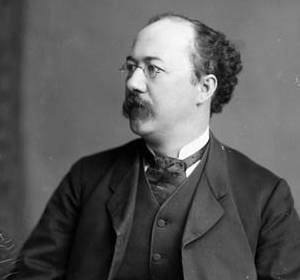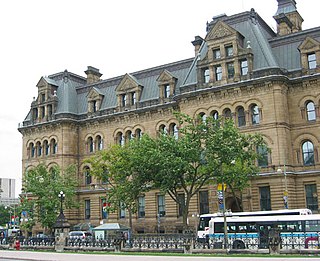The office of Minister of Customs was a position in the Cabinet of the Government of Canada responsible for the administration of customs revenue collection. This position was originally created by Statute 31 Vict., c. 43, and assented to on 22 May 1868.
The Cabinet of Canada is a body of ministers of the Crown that, along with the Canadian monarch, and within the tenets of the Westminster system, forms the government of Canada. Chaired by the prime minister, the Cabinet is a committee of the Queen's Privy Council for Canada and the senior echelon of the Ministry, the membership of the Cabinet and ministry often being co-terminal; as of November 2015 there are no members of the latter who are not also members of the former.
The Government of Canada, officially Her Majesty's Government, is the federal administration of Canada. In Canadian English, the term can mean either the collective set of institutions or specifically the Queen-in-Council. In both senses, the current construct was established at Confederation through the Constitution Act, 1867—as a federal constitutional monarchy, wherein the Canadian Crown acts as the core, or "the most basic building block", of its Westminster-style parliamentary democracy. The Crown is thus the foundation of the executive, legislative, and judicial branches of the Canadian government. Further elements of governance are outlined in the rest of the Canadian Constitution, which includes written statutes, court rulings, and unwritten conventions developed over centuries.

“Customs” means the Government Service which is responsible for the administration of Customs law and the collection of duties and taxes and which also has the responsibility for the application of other laws and regulations relating to the importation, exportation, movement or storage of goods.
From 3 December 1892, the Minister's position was cancelled in favour of a Controller of Customs position which was treated as part of the Ministry, but not part of the formal Cabinet. A similar change was also made to the Minister of Inland Revenue portfolio at that time.
In constitutional usage in Commonwealth realms and in some other systems, a ministry is a collective body of government ministers headed by a prime minister or premier, and also referred to as the head of government. It is described by the Oxford Dictionary as "a period of government under one prime minister". Although the term "cabinet" can in some circumstances be a synonym, a ministry can be a broader concept which might include office-holders who do not participate in cabinet meetings. Other titles can include "administration" or "government" to describe similar collectives.
The Controller of Customs became part of the Cabinet on 24 December 1895 when John Fisher Wood became a part of the Privy Council. The position once again became known as Minister of Customs with the passage of Statute 60-61 Vict., c. 18 which was given royal assent on 29 June 1897. The same legislation also brought back the title of Minister of Inland Revenue.

John Fisher Wood, was an Ontario businessman, lawyer and politician. He represented Brockville in the House of Commons of Canada as a Liberal-Conservative from 1882 to 1899.

The Queen's Privy Council for Canada, sometimes called Her Majesty's Privy Council for Canada or simply the Privy Council, is the full group of personal consultants to the monarch of Canada on state and constitutional affairs. Responsible government, though, requires the sovereign or her viceroy, the Governor General of Canada, to almost always follow only that advice tendered by the Cabinet: a committee within the Privy Council composed usually of elected Members of Parliament. Those summoned to the QPC are appointed for life by the governor general as directed by the Prime Minister of Canada, meaning that the group is composed predominantly of former cabinet ministers, with some others having been inducted as an honorary gesture. Those in the council are accorded the use of an honorific style and post-nominal letters, as well as various signifiers of precedence.
The offices of Minister of Customs and Minister of Inland Revenue were replaced by a combined Minister of Customs and Inland Revenue, as mandated by Order in Council dated 18 May 1918.
The Minister of Inland Revenue was a portfolio in the Canadian Cabinet from 1867 until 1918 when it became the Minister of Customs and Inland Revenue. In 1927, the portfolio became the Minister of National Revenue.
An Order in Council is a type of legislation in many countries, especially the Commonwealth realms. In the United Kingdom this legislation is formally made in the name of the Queen by and with the advice and consent of the Privy Council (Queen-in-Council), but in other countries the terminology may vary. The term should not be confused with Order of Council, which is made in the name of the Council without royal assent.

Her Majesty's Most Honourable Privy Council, usually known simply as the Privy Council of the United Kingdom or just the Privy Council, is a formal body of advisers to the Sovereign of the United Kingdom. Its membership mainly comprises senior politicians who are current or former members of either the House of Commons or the House of Lords.

The Statute of Westminster 1931 is an Act of the Parliament of the United Kingdom whose modified versions are now domestic law within Australia and Canada; it has been repealed in New Zealand and implicitly in former Dominions that are no longer Commonwealth realms. Passed on 11 December 1931, the act, either immediately or upon ratification, effectively both established the legislative independence of the self-governing Dominions of the British Empire from the United Kingdom and bound them all to seek each other's approval for changes to monarchical titles and the common line of succession. It thus became a statutory embodiment of the principles of equality and common allegiance to the Crown set out in the Balfour Declaration of 1926. As the statute removed nearly all of the British parliament's authority to legislate for the Dominions, it had the effect of making the Dominions largely sovereign nations in their own right. It was a crucial step in the development of the Dominions as separate states.
The Right Honourable is an honorific style traditionally applied to certain persons and collective bodies in the United Kingdom, Canada, Australia, New Zealand, Fiji, some other Commonwealth realms, the English-speaking Caribbean, Mauritius, Zimbabwe, and occasionally elsewhere. The term is predominantly used today as a style associated with the holding of certain senior public offices in the United Kingdom, Canada, and New Zealand.
The Council of State is the privy council of Denmark. The body of advisors to the Danish sovereign, the council is a formal institution, with largely ceremonial functions. Chaired by the sovereign, the council comprises all cabinet ministers and the crown prince or hereditary princess when he or she is of age. When unavailable, the sovereign is represented by the regent or Lord Protector.
Minister of the Crown is a formal constitutional term used in Commonwealth realms to describe a minister to the reigning sovereign or their viceroy. The term indicates that the minister serves at His/Her Majesty's pleasure, and advises the sovereign or viceroy on how to exercise the Crown prerogatives relative to the minister's department or ministry.

The Leader of the Government in the House of Commons, more commonly known as the Government House Leader, is the Cabinet minister responsible for planning and managing the government's legislative program in the House of Commons of Canada.
A Minister of State is a junior cabinet minister in the Cabinet of Canada, usually given specific responsibilities to assist a senior cabinet minister in a specific area. A Secretary of State also holds many similar responsibilities in assisting senior cabinet members, being members of the Ministry and the Queen's Privy Council for Canada. A Secretary of State is legally a Minister of State styled as secretaries. However Secretaries of State are considered junior to ministers of state and are not members of Cabinet.

The Twenty-Eighth Canadian Ministry was the combined Cabinet, chaired by Prime Minister Stephen Harper, and Ministers that governed Canada from the beginning of the 39th Parliament to the end of the 41st Parliament. Its original members were sworn into the Queen's Privy Council for Canada on February 6, 2006, exactly two weeks after the 2006 election, and nine weeks and six days after the end of the 38th Canadian Parliament. Smaller than its recent predecessors, the Conservative Cabinet originally consisted of 27 members, including the prime minister. On January 4, 2007, five Secretaries of State were added to the ministry who are not members of the Cabinet itself. The cabinet resigned on the morning of November 4, 2015.

The Eighth Canadian Ministry was the cabinet chaired by Prime Minister Sir Wilfrid Laurier. It governed Canada from 11 July 1896 to 5 October 1911, including all of the 8th, 9th, 10th, and 11th Canadian Parliaments. The government was formed by the Liberal Party of Canada.

The Seventh Canadian Ministry was the cabinet chaired by Prime Minister Sir Charles Tupper. It governed Canada from 1 May to 8 July 1896. It was formed after the 7th Canadian Parliament was dissolved, and lost the 8th Canadian federal election, so it never faced a parliament. The government was formed by the old Conservative Party of Canada.

The Sixth Canadian Ministry was the cabinet chaired by Prime Minister Sir Mackenzie Bowell. It governed Canada from 21 December 1894 to 27 April 1896, including only the last year of the 7th Canadian Parliament. The government was formed by the old Conservative Party of Canada.

The Fifth Canadian Ministry was the cabinet chaired by Prime Minister Sir John Sparrow Thompson. It governed Canada from 5 December 1892 to 12 December 1894, including only two years in the middle of the 7th Canadian Parliament. The government was formed by the old Conservative Party of Canada.
The position of Minister of Mines and Resources was a cabinet portfolio in Canada from 1936 to 1950. The mines portfolio had previously been that of the Minister of Mines, which was a portfolio adjunct to other ministries such as Inland Revenue and Indian Affairs.
The position of Minister of Customs and Inland Revenue was a Minister of the Crown in the Canadian Cabinet responsible for the collection of taxes and duties and created in 1918 by combining the former positions of Minister of Inland Revenue and Minister of Customs. In 1921, the office of Minister of Customs and Inland Revenue was abolished and the office of Minister of Customs and Excise was created by Statute 11-12 Geo. V, c. 26, and assented to on 4 June 1921. In 1927 the Department of Customs and Excise was abolished and replaced by the Department of National Revenue, and portfolio became the Minister of National Revenue.
The position of Minister of Mines was a Minister of the Crown in the Canadian Cabinet responsible for the mining industry. The Department of Mines was created by the government of Sir Wilfrid Laurier by Statute 6-7 Edw,. VII, c. 29. and assented to on 27 April 1907. The department was to be presided over by the minister of another department who was to be named by the Governor in Council and who was to be called "The Minister of Mines". The Minister of Inland Revenue was the first to be named Minister of Mines. In 1936, the mines portfolio became part of the Minister of Mines and Resources, in 1950, Minister of Mines and Technical Surveys, in 1966 the Minister of Energy, Mines and Resources, and since 1995 the Minister of Natural Resources.










